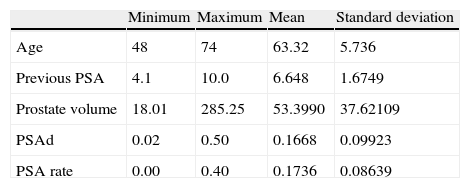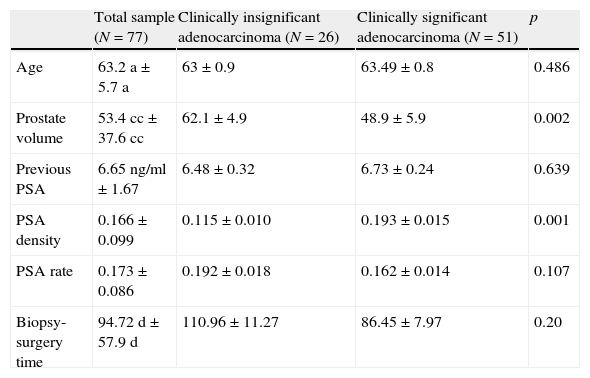The aim of this study was to identify the rate of clinical significant disease (Gleason score>6 or tumor volume>0.5cc in the RP specimen) among patients who had an insignificant prostate cancer on biopsy, evaluating the presence of prognostic factors.
Patients and methodsPatients who fulfilled the following criteria were included: PSA≤10ng/ml, T1c disease, biopsy Gleason Score≤6 affecting <5% of only 1 core and who had undergone a radical prostatectomy. The following variables were studied: Age, PSA, dPSA, free/total PSA ratio and prostatic volume assessed by transrectal ultrasound.
ResultsIn a series of 2424 biopsies, 77 patients completely fulfilled the inclusion criteria, with 66.23% (n=51) of clinical significant disease in the prostatectomy specimen. No differences were observed between these patients and those with insignificant disease in age, PSA, free/total PSA ratio. However, prostatic volume was significantly greater and PSA density significantly lower in those patients with an insignificant disease. Statistical analysis using a logistical regression showed that dPSA was the only prognostic factor (OR: 25,067.10, CI 95%: 26.79–2.34×107, p=.004).
ConclusionsThese findings suggest that a high rate of patients who have a suspected insignificant prostate cancer on biopsy have a clinical significant disease, dPSA being the only independent prognostic factor.
El objetivo de este trabajo es conocer el porcentaje de pacientes que, cumpliendo criterios de adenocarcinoma insignificante de próstata en la biopsia, tiene realmente un tumor clínicamente significante en la pieza de prostatectomía, analizando si existe algún factor pronóstico para cáncer clínicamente significante.
Material y métodoSeleccionamos como cánceres potencialmente insignificantes aquellos con PSA ≤ 10ng/ml, estadio T1c, puntuación de Gleason en la biopsia ≤ 6, afectando un solo cilindro, con menos del 5% de tumor e intervenidos de prostatectomía radical. Analizamos las variables: edad, PSA previo, densidad de PSA, cociente PSA libre/total, volumen ecográfico prostático y la relación con la presencia de cáncer clínicamente insignificante o significante en la pieza quirúrgica. Se realizó un análisis de regresión logística múltiple para conocer si alguna de las variables podría tener valor predictivo sobre la presencia de cáncer significante.
ResultadosEntre el 1 de enero de 2003 y el 31 de julio de 2009 se realizaron 2.424 biopsias, entre las cuales 77 pacientes cumplieron los criterios de inclusión. Cincuenta y uno (66,23%) presentaron cáncer clínicamente significativo en la pieza de prostatectomía radical. Mediante análisis univariante se comprobó que el volumen prostático fue significativamente mayor y la densidad de PSA significativamente menor en los cánceres clínicamente insignificantes, sin diferencias en el resto de variables estudiadas. El análisis mediante regresión logística muestra la densidad de PSA como único factor con valor predictivo, de tal forma que a mayor densidad de PSA mayor probabilidad de que el tumor sea clínicamente significativo (OR: 25067,101; IC 95%: 26,79–2,34×107; p=0,004).
ConclusiónLos hallazgos del presente estudio sugieren que un porcentaje alto de pacientes con sospecha de cáncer de próstata insignificante en la biopsia tienen en realidad un tumor clínicamente significante, siendo la densidad de PSA el único factor predictivo independiente.









